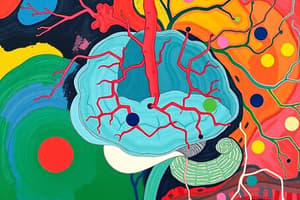Podcast
Questions and Answers
Which component of the motor system is under conscious control?
Which component of the motor system is under conscious control?
- Sympathetic nervous system
- Somatic nervous system (correct)
- Autonomic nervous system
- Enteric nervous system
Where are the cell bodies of the preganglionic neurons in the autonomic nervous system located?
Where are the cell bodies of the preganglionic neurons in the autonomic nervous system located?
- In autonomic ganglia
- Peripheral nervous system
- Central nervous system (correct)
- Brain stem
Which part of the autonomic nervous system controls functions primarily of visceral organs?
Which part of the autonomic nervous system controls functions primarily of visceral organs?
- Sympathetic nervous system (correct)
- Enteric nervous system
- Parasympathetic nervous system
- Somatic nervous system
How many neurons are involved in each pathway of the autonomic nervous system?
How many neurons are involved in each pathway of the autonomic nervous system?
Where do the axons of postganglionic neurons synapse in the autonomic nervous system?
Where do the axons of postganglionic neurons synapse in the autonomic nervous system?
What neurotransmitter do all preganglionic neurons of the autonomic nervous system release?
What neurotransmitter do all preganglionic neurons of the autonomic nervous system release?
Which system promotes salivation, urination, and defecation?
Which system promotes salivation, urination, and defecation?
Which system lowers the heart rate and narrows the coronary arteries?
Which system lowers the heart rate and narrows the coronary arteries?
Which system dilates the pupils and encourages the eyes to receive more information?
Which system dilates the pupils and encourages the eyes to receive more information?
Which system narrows the bronchi and bronchioles?
Which system narrows the bronchi and bronchioles?
Which statement is true about the parasympathetic nervous system?
Which statement is true about the parasympathetic nervous system?
Which function is not associated with the sympathetic nervous system?
Which function is not associated with the sympathetic nervous system?
What controls the pupillary constrictor muscle?
What controls the pupillary constrictor muscle?
What is the effect of activating muscarinic receptors on the pupil?
What is the effect of activating muscarinic receptors on the pupil?
What type of innervation do sweat glands have?
What type of innervation do sweat glands have?
In the accommodation response, what leads to pupillary constriction?
In the accommodation response, what leads to pupillary constriction?
What happens when the parasympathetic system is activated in the gastrointestinal tract?
What happens when the parasympathetic system is activated in the gastrointestinal tract?
Which receptors control the pupillary constriction muscle?
Which receptors control the pupillary constriction muscle?
Flashcards are hidden until you start studying
Study Notes
Motor System and Conscious Control
- The somatic motor system is the component of the motor system under conscious control, allowing voluntary movements.
Autonomic Nervous System Structure
- Cell bodies of preganglionic neurons are located in the central nervous system (CNS), specifically within the brainstem and spinal cord.
- The autonomic nervous system (ANS) consists of two major divisions: sympathetic and parasympathetic, with distinct functional roles.
Functions of the Autonomic Nervous System
- The parasympathetic division primarily controls functions of visceral organs, promoting restorative processes like digestion and relaxation.
- Each pathway in the autonomic nervous system involves two neurons: a preganglionic neuron and a postganglionic neuron.
Synapses in the Autonomic Nervous System
- Axons of postganglionic neurons synapse at target organs or tissues, facilitating the control of involuntary functions.
Neurotransmitters in the Autonomic Nervous System
- Preganglionic neurons of the autonomic nervous system release acetylcholine, a common neurotransmitter for both sympathetic and parasympathetic systems.
Sympathetic and Parasympathetic Systems
- The parasympathetic nervous system promotes salivation, urination, and defecation as part of its restorative functions.
- The parasympathetic system lowers heart rate and constricts coronary arteries, supporting calming and restorative actions.
- The sympathetic nervous system dilates pupils, allowing increased light entry and enhancing visual input.
- The sympathetic system narrows bronchi and bronchioles to facilitate focused breathing under stress or threat.
Parasympathetic Nervous System Characteristics
- True statements about the parasympathetic nervous system include its role in conserving energy and enhancing digestion.
- Functions that are not associated with the sympathetic nervous system typically include energy conservation and relaxing processes.
Pupillary Control and Responses
- The pupillary constrictor muscle is controlled by the parasympathetic nervous system, which reduces pupil size.
- Activation of muscarinic receptors on the pupil results in constriction, enhancing visual acuity under bright light conditions.
- Sweat glands receive sympathetic innervation despite their role in thermoregulation, indicating a unique dual control within the autonomic system.
Accommodation Response
- In the accommodation response, pupillary constriction is prompted by increased light exposure, regulating light entry for clear vision.
- Activation of the parasympathetic system in the gastrointestinal tract stimulates digestive processes, increasing motility and secretion for effective digestion.
Receptors and Pupil Function
- Receptors controlling the pupillary constrictor muscle include muscarinic acetylcholine receptors, which mediate constriction in response to light and near focus.
Studying That Suits You
Use AI to generate personalized quizzes and flashcards to suit your learning preferences.




